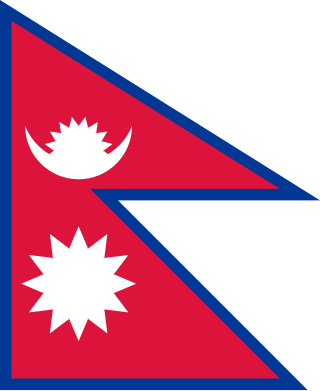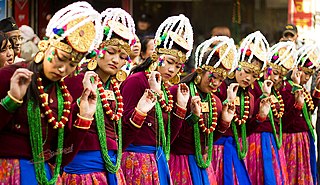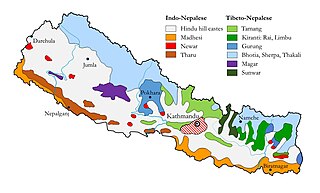
The national flag of Nepal is the world's only non-rectangular flag which is used as both the state flag and civil flag of a sovereign country. The flag is a simplified combination of two single pennons, known as a double-pennon. Its crimson red is the symbol of bravery and it also represents the color of the rhododendron, Nepal's national flower, while the blue border is the color of peace. Until 1962, the flag's emblems, both the sun and the crescent moon, had human faces, but they were removed to modernize the flag.

Nepal, officially the Federal Democratic Republic of Nepal, is a landlocked country in South Asia. It is mainly situated in the Himalayas, but also includes parts of the Indo-Gangetic Plain. It borders the Tibet Autonomous Region of China to the north, and India to the south, east, and west, while it is narrowly separated from Bangladesh by the Siliguri Corridor, and from Bhutan by the Indian state of Sikkim. Nepal has a diverse geography, including fertile plains, subalpine forested hills, and eight of the world's ten tallest mountains, including Mount Everest, the highest point on Earth. Kathmandu is the nation's capital and the largest city. Nepal is a multi-ethnic, multi-lingual, multi-religious and multi-cultural state, with Nepali as the official language.

The yak, also known as the Tartary ox, grunting ox, or hairy cattle, is a species of long-haired domesticated cattle found throughout the Himalayan region of Gilgit-Baltistan, Nepal, Sikkim (India), the Tibetan Plateau, (China), Tajikistan and as far north as Mongolia and Siberia. It is descended from the wild yak.

Magar Kham, also known as Kham, Kham Magar, and Khamkura, is the Sino-Tibetan language variety of the Northern Magar people of Nepal. The language is situated in the upper elevations of Baglung, East Rukum, and Rolpa districts. Based on census data taken in 2011, the total population of Magar Kham is estimated to be about 69,000 speakers.

Gurung or Tamu are an ethnic group living in the hills and mountains of Gandaki Province of Nepal. Gurung people predominantly live around the Annapurna region in Manang, Mustang, Dolpo, Kaski, Lamjung, Gorkha, Parbat,Tanahun and Syangja districts of Nepal.

The culture of Nepal encompasses the various cultures belonging to the 125 distinct ethnic groups present in Nepal. The culture of Nepal is expressed through music and dance; art and craft; folklore; languages and literature; philosophy and religion; festivals and celebration; foods and drinks.

The Emblem of Nepal is the national emblem of Nepal and is used by the Government of Nepal and many government agencies. On 13 June 2020, the emblem was revised to include the newly issued map which includes Nepalese claims to the Kalapani territory and Lipulekh Pass.

Ethnic groups in Nepal are delineated using language, ethnic identity or the caste system in Nepal. They are categorized by common culture and endogamy. Endogamy carves out ethnic groups in Nepal.

The Dhaka topi, or Nepali topi, is a hat which is popular in Nepal, and which forms part of Nepalese national dress, worn by men on celebrations.

Wildlife diversity is a notable feature of Nepal. Because of the variance in climate, from tropical to arctic, Nepal has a large variety of plants and animals. Wildlife tourism is a major source of tourism in the country. There are some animal species which are unique to Nepal, such as the spiny babbler. Nepal is also host to many rhododendron species. Nepal has numerous national parks and reserves to protect its diverse fauna. Nepal is a biodiversity hot spot with ecoregions broadly comprising the mountainous ecoregion, the savanna and grasslands ecoregion of the terai (foothills), and the Rara Lake ecoregion.

There are two dozen languages of Bhutan, all members of the Tibeto-Burman language family except for Nepali, which is an Indo-Aryan language, and Bhutanese Sign Language. Dzongkha, the national language, is the only native language of Bhutan with a literary tradition, though Lepcha and Nepali are literary languages in other countries. Other non-Bhutanese minority languages are also spoken along Bhutan's borders and among the primarily Nepali-speaking Lhotshampa community in South and East Bhutan. Chöke is the language of the traditional literature and learning of the Buddhist monastics.
Vayu (वायु), Wayu or Hayu (हायु) is a Sino-Tibetan language spoken in Nepal by about 1,520 people in Bagmati Province. Dialects include Pali gau Mudajor Sukajor Ramechhap Sindhuli and Marin Khola.

South Asia is home to several hundred languages, spanning the countries of Afghanistan, Bangladesh, Bhutan, India, Maldives, Nepal, Pakistan, and Sri Lanka. It is home to the third most spoken language in the world, Hindi–Urdu; and the sixth most spoken language, Bengali. The languages in the region mostly comprise Indo-Iranic and Dravidian languages, and further members of other language families like Austroasiatic, and Tibeto-Burman languages.

Rara National Park is a protected area in the Himalayas of Nepal and was established in 1976. Covering an area of 106 km2 (41 sq mi) in the Mugu and Jumla districts, it is the country's smallest national park. Its main feature is Rara Lake at an altitude of 2,990 m (9,810 ft). The park was established to protect the unique flora and fauna of the Humla–Jumla Region of Nepal.

Daura-Suruwal is one of the national outfit of Nepalese men. The Daura is a variant of the Kurta and is the upper garment, the Suruwal is the trouser. The coat was added to the costume by Jang Bahadur Rana, a prime minister of Nepal in the 19th century. The outfit is also popular in Darjeeling in neighbouring India amongst people of Indian Gorkha origin.
Byangsi is a West Himalayish language of India and Nepal. Estimates of numbers of speakers vary, but some sources say that the language is spoken by about 1,000-1,500 people, while others estimate as many as 3,300. Byangsi is from a region of high language density, that is to say that there are many languages among few people. It is the most dominant language in this region, although it is not widely known outside of its small hill district and those who speak it have difficulty classifying themselves for central government dealings.
Manang, also called Manangba, Manange, Manang Ke, Nyishang, Nyishangte and Nyishangba, is a Sino-Tibetan language spoken in Nepal. Native speakers refer to the language as ŋyeshaŋ, meaning 'our language'. Manang and its most closely related languages are often written as TGTM in literature, referring to Tamang, Gurung, Thakali, and Manangba, due to the high degree of similarity in the linguistic characteristics of the languages. The language is unwritten and almost solely spoken within the Manang District, leading it to be classified as threatened, with the number of speakers continuing to decline. Suspected reasons for the decline include parents not passing down the language to their children, in order to allow for what they see as more advanced communication with other groups of people, and thus gain more opportunities. Due to the proximity of the district to Tibet, as well as various globally widespread languages being introduced into the area, use of the native language is declining in favor of new languages, which are perceived to aid in the advancement of the people and region.
Tsum is a language from the subgroup of Tibetic languages spoken by the Tsum people primarily in the Tsum Valley of the Gorka District of Nepal. The language is also known as Tsumke.

Ramaroshan is located in Achham district of Nepal at the altitude of 2500m. A place having 18 patch of meadows, is a major tourism site of Achham district. This area is the one of the habitat of national bird of Nepal, Danfe (Lophophorus). A good view of Budhiganga basin, along with the peaks of Mount Api, and Mount Saipal can be seen from Ramaroshan area.
The Himalayan country named Nepala with its capital in Kathmandu Valley was well-known in the Indian sub-continent by at least 2,500 years ago. Historical discussions on the etymology of Nepal incorporated elements of Hindu and Buddhist History. The origin of the term Nepal is an area of ongoing investigation. Multiple hypotheses have been put forward by modern scholars to varying level of support. It is generally accepted that Nepal and Newar—the latter refers to the ethnic group indigenous to the Kathmandu Valley—are different forms of the same word.



















